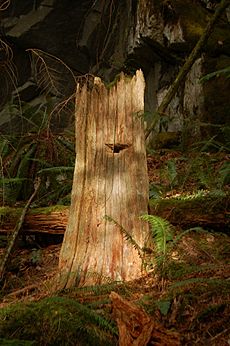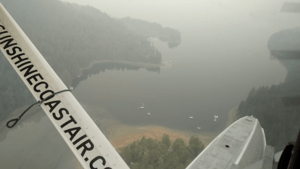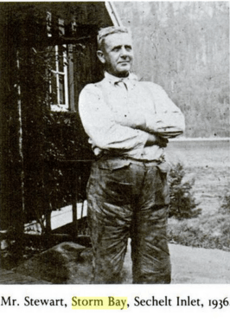Storm Bay (British Columbia) facts for kids
Storm Bay is a beautiful bay located in the Sechelt Inlet, which is part of the Pacific Ocean. It's found close to where Narrows Inlet meets the larger Sechelt Inlet.
You can reach Storm Bay by boat or by a special small airplane called a seaplane. Since the middle of the 1960s, this area has been a home for many well-known artists.
Contents
Nature and Environment in Storm Bay
Storm Bay is part of a special natural area in British Columbia called the Coastal Douglas-fir Biogeoclimatic Zone. This zone is known for its wet, mossy, and thick temperate rainforests. Imagine a forest that gets lots of rain, making it very green and full of life!
History of Storm Bay

Storm Bay has a long and interesting history, especially with the people who lived there first and those who came later.
The shíshálh Nation's Long History
For about 8,000 years, the shíshálh (also known as the Sechelt) nation has lived in Storm Bay. Specifically, a group called the téwánkw, which includes people from ?álhtulich, stl'ixwim, and skúpa (Sechelt, Narrows, and Salmon Inlets), made this their home. We know they lived here for a very long time because of ancient piles of shells called shell middens. These middens are like old garbage dumps that show where people lived and what they ate.
Early 1900s: Logging and Settlements
In the early 1900s, Storm Bay saw a lot of logging, which means trees were cut down for wood. People also started homesteading here, which is when families claimed land to build homes and farms.
There were even attempts to build brick factories in Storm Bay. In 1907, a company tried to make bricks, but it closed after two years because the clay wasn't good enough. Later, in 1921, the Canadian government built another large brick plant to help soldiers who had returned from war find jobs. However, this factory also didn't last very long.
Artists and Community Since the 1960s
In the late 1960s and early 1970s, many people who were interested in living together in a special way, often called an intentional community, moved to Storm Bay. These included famous artists like Kate Craig (who passed away in Storm Bay in 2002), David Rimmer, Karen Jamieson, Hank Bull, and Glenn Lewis.
Even though some people might have called Storm Bay a "commune" (a place where people live together and share resources), the people living there prefer to call it a "neighbourhood." They see it as a community where people live close by and support each other.



